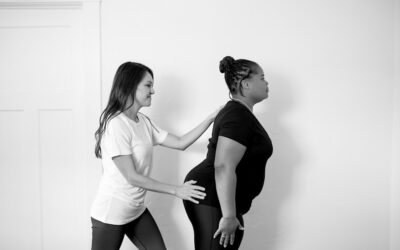During back-to-school time, the thought of returning to your busy classrooms can be stressful in more ways than one. Today, we’re tackling one of those stressors I can actually help you with: teacher bladder.
Approximately 50% of teachers report inadequate bathroom breaks, and the resulting bladder issues are no joke.
What is Teacher Bladder?
Teacher bladder, also called infrequent bladder syndrome, is the increased bladder and pelvic floor issues teachers experience due to their job demands. And you might be surprised to learn, it’s not just about the infrequent bathroom breaks.
Chronic stress, raising your voice, hard floors, leaning over desks and tables, squatting, and other common teacher activities can also affect your pelvic floor.
When your pelvic floor is under a lot of stress, you might start to notice some not-so-pleasant effects on your bladder and urinary function. If you’ve noticed increased frequency, urgency, or leakage, you’re likely familiar with teacher bladder. Let’s talk about some teacher bladder health tips!
Is it Bad to Hold Your Pee?
Yes. In the short-term, delaying urination can lead to pain and discomfort in the bladder or kidneys. This can happen before and after peeing, as your muscles stay partially contracted after releasing your urine.
In the long-term, holding your pee puts you at greater risk for:
- Urinary tract infections.
- Bladder stretching
- Kidney stones.
- Pelvic floor muscle tension.
7 Tips for Proper Peeing and Avoid Teacher Bladder
When you do get a chance to head to the bathroom, make the most of your visit! Use these tips to keep your bladder as healthy as possible.
#1 Never go “just in case.”
It’s so tempting to go “just-in-case” when you have the chance. But this can confuse your bladder and make your trips more frequent in the long-term.
Here’s why: As the bladder stretches to hold more urine, it sends us signals so we can start heading to the bathroom. When we just-in-case pee, we train our bodies to respond to bladder urges when it’s not quite time to go. Over time, our bladders shrink in response, leading to an overactive bladder and increased urinary frequency.
#2 Avoid hovering.
We all want to avoid public toilet germs, right? But hovering over the toilet seat clenches the pelvic floor and can make it difficult to fully empty the bladder. Then, we often have to push and strain to finish urinating. It’s a lose-lose situation!
#3 Stop power peeing.
Avoid pushing or straining to get your urine out quickly. All that extra pressure can make the pelvic floor too weak or too tense. So instead, sit, relax, and breathe! Help your body do its thing!
#4 Say no to fragrance.
Store shelves are lined with product after product that claim to be good for your down there. But fragrances and other chemicals can irritate your urethra, increasing your bathroom trips.
#5 Adjust your lifestyle.
Lifestyle factors, like diet and posture, can make a big difference for your pelvic floor. Be sure to keep a good posture, especially when standing, leaning, or sitting for long periods of time. You can also adjust your diet by avoiding caffeine, carbonated drinks, and spicy foods! All of these are bladder irritants that can make you need to go more often.
#6 Prevent dehydration.
Plenty of people think they shouldn’t drink water too often for fear they’ll have to pee more often. But the truth is, staying hydrated and regulating your fluid intake might actually help you go less!
When the body isn’t hydrated properly, urine becomes more concentrated. The bladder then gets the strong urge to empty so it can get rid of this extra-strong pee. Sipping water slowly throughout the day fills the bladder more slowly and can keep your urine concentration to optimal levels.
#7 Know the signs of a UTI.
Urinary tract infections (UTIs) happen when bacteria enters the urethra and can be exacerbated by not peeing often enough. The symptoms are hard to ignore:
- Urinary frequency (more than 8 times in 24 hours).
- Urinary urgency.
- Urinary leakage.
- Ability to produce only small amounts of urine at a time.
- Pain or discomfort in the abdomen or pelvis.
- Bloody or cloudy urine.
If you suspect a UTI, chat with your healthcare provider right away.
How to Suppress the Urge to Pee
In the ideal situation, when you get the urge to pee, you can pause what you are doing, get to the restroom, and empty the tank. But for many, that’s just not possible.
Normal urination should happen every 2-4 hours. There are some things you can do to practice bladder training until you can get to a toilet during your next break. Try to:
- Distract yourself.
- Take long, relaxing, deep breaths.
- Sit or stand as still as possible.
- Perform 5-10 pelvic floor contractions (Kegels) to quiet your bladder’s urge.
How to Poop at School
Having inadequate bathroom breaks means that pooping at school can also be extra difficult. But the same rules apply here, too!
- Stay hydrated,
- Go when you need to go.
- Avoid straining by exhaling when you bear down.
- Lift your heels and lean forward if you don’t have a pooping stool or squatty potty available.
You’ve got this!
Take excellent care down there.
Part of maintaining healthy bladder habits means taking great care of your pelvic floor and core. That’s why I developed The V-Hive Membership, giving you access to on-demand, online workouts to prevent or overcome common pelvic floor problems.





